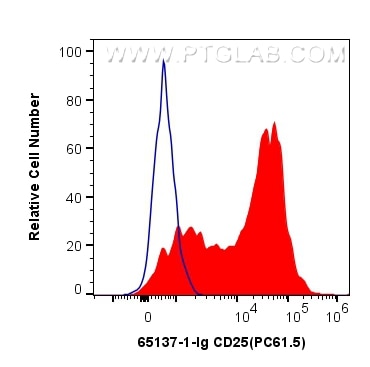Anticorps Monoclonal anti-CD25
CD25 Monoclonal Antibody for FC
Hôte / Isotype
Rat / IgG1, lambda
Réactivité testée
souris
Applications
FC
Conjugaison
Non conjugué
CloneNo.
PC61.5
N° de cat : 65137-1-Ig
Synonymes
Galerie de données de validation
Applications testées
| Résultats positifs en cytométrie | Anti-CD3 and Anti-CD28 stimulated mouse splenocytes |
Dilution recommandée
| Application | Dilution |
|---|---|
| This reagent has been tested for flow cytometric analysis. It is recommended that this reagent should be titrated in each testing system to obtain optimal results. | |
| Sample-dependent, check data in validation data gallery | |
Informations sur le produit
65137-1-Ig cible CD25 dans les applications de FC et montre une réactivité avec des échantillons souris
| Réactivité | souris |
| Hôte / Isotype | Rat / IgG1, lambda |
| Clonalité | Monoclonal |
| Type | Anticorps |
| Immunogène | s/o |
| Nom complet | interleukin 2 receptor, alpha chain |
| Numéro d’acquisition GenBank | BC114437 |
| Symbole du gène | Il2ra |
| Identification du gène (NCBI) | 16184 |
| Conjugaison | Non conjugué |
| Forme | Liquide |
| Méthode de purification | Purification par affinité |
| Tampon de stockage | PBS with 0.09% sodium azide. |
| Conditions de stockage | Store at 2-8°C. Stable for one year after shipment. |
Informations générales
Proliferation of T lymphocytes is triggered by the interaction of IL-2 with its specific receptor following T lymphocyte activation. The receptor for IL-2 has three forms, generated by different combinations of three different proteins, the alpha chain (IL-2R alpha), the beta chain (IL-2R beta), and the gamma chain (IL-2R gamma) (PMID: 8476561). IL-2R alpha (also known as CD25) is a type I transmembrane protein present on activated T cells, activated B cells, some thymocytes, myeloid precursors, and oligodendrocytes. CD25 is also found on natural CD4+Foxp3+ Treg cells (PMID: 22585674).
Protocole
| Product Specific Protocols | |
|---|---|
| FC protocol for CD25 antibody 65137-1-Ig | Download protocol |
| Standard Protocols | |
|---|---|
| Click here to view our Standard Protocols |


